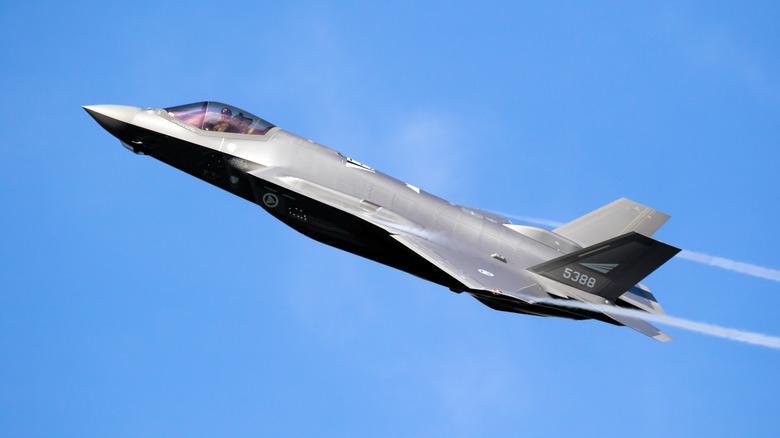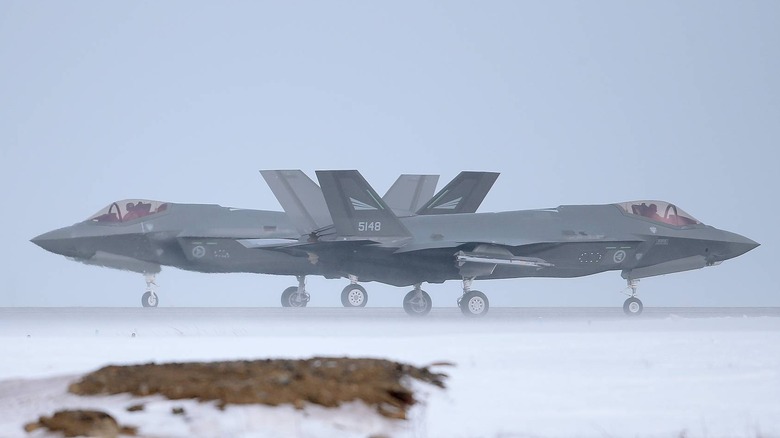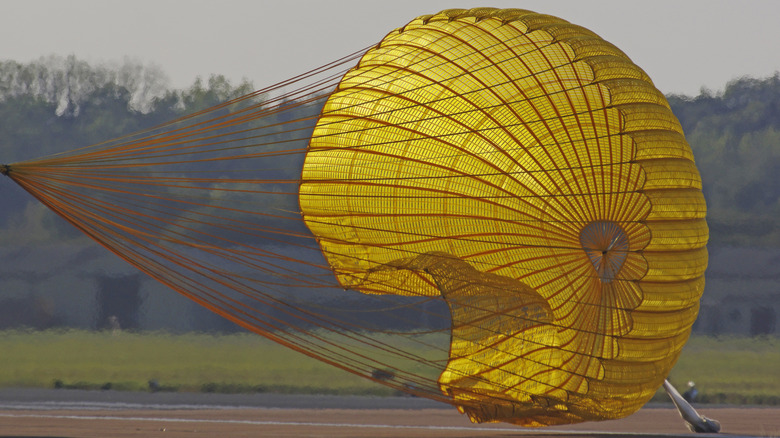Why Do Norwegian F-35's Have A Bump On The Back?
The F-35 is a fifth-generation fighter that is one of the most advanced jet fighters in the world. Bristling with a host of next-generation technologies and designed with a focus on that all-important stealthiness that modern air forces demand. The F-35 is also one of the most exported U.S. jet fighters, with over 1,000 jets in service in numerous air forces. In general, there are three variants of the F-35 available to air forces. These are the F-35A, the F-35B, and — unsurprisingly — the F-35C. For the purposes of this article, the F-35A is the variant of interest. More specifically, the F-35As of the Royal Norwegian Air Force (RNoAF), which could be described as a variant within a variant.
What makes Norwegian F-35s different from those of other countries is the strange bump on the back of the plane. Situated between the fighter's vertical stabilizers, the bump looks like it could house additional sensors or jamming technology. However, the truth is that this unique feature doesn't contain advanced electronics; its sole purpose is to help Norwegian F-35A pilots operate in Norway's often harsh climate. The "bump" is actually a removable pod that contains a drag chute that helps the plane rapidly decelerate on short, slippery runways typical of Arctic environments. Let's have a closer look at the curious case of the Norwegian F-35 bump and the hidden parachute.
How the drag chute works
At first glance, it isn't always easy to spot the difference between a "pod-carrying" F-35A and a typical version. The pod is situated between the vertical stabilizers and is designed to maintain the overall stealth ethos of the fighter jet. It's also a modular design that allows the pod to be installed or removed quickly and with a minimum of fuss. The mechanics of how drag chutes work is simple: they add drag to the aircraft to supplement existing braking or aerodynamic decelerators. The system has been used in various aircraft, including fighters like the F-4 and F-16, the SR-71 spy plane, the space shuttle, and even civilian craft with the Tu-144 — Russia's terrifying Concorde rip-off being an infamous example.
The parachute needs to be sturdy enough to cope with the weight of an F-35 — the maximum take-off weight is 70,000 pounds — to cope with these demands the chute is made of Kevlar. In the Norwegian F-35A system, the parachute is deployed by the pilot using a switch located to the left of the instrument panel, the same switch is used to disconnect the parachute once the plane has stopped. As well as helping the plane slow, the aerodynamic drag provided by the chute helps to provide better control for the pilots on potentially icy surfaces.
A bit of a drag at first
The concept of a drag parachute is simple and can be considered a fairly rudimentary technology, especially when compared to the rest of the high-tech present in one of the most advanced jet fighters currently flying. It's also a well-understood system with a proven track record on various aircraft. So, it may be surprising to hear that deploying such a known and mature technology should be beset by problems — yet, it was, at least initially. The original requirement for the RNoAF was for the system to operate with a failure rate of one failed opening every 10,000 uses. While it was never disclosed just what the actual failure rate was, the Norwegians made it clear that it wasn't meeting the required standard. This necessitated some design modifications to the system, including to the parachute deployment bag and the pilot chute (the pilot chute is the small parachute that deploys first to pull the main canopy out of the pod).
These fixes were targeted for delivery in 2020, but official confirmation that the problem was fully resolved remains elusive. That said, Norway didn't appear deterred — the country went on to become the first allied nation to complete its F-35A procurement program, receiving its final aircraft in 2024. It seems the bump on the back wasn't such a drag after all.


